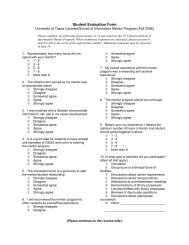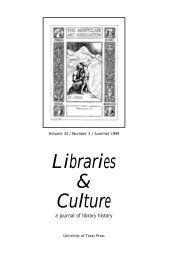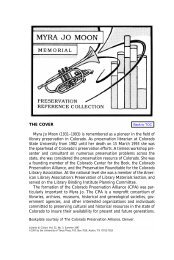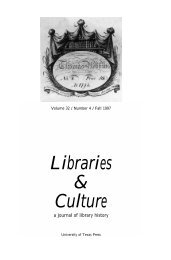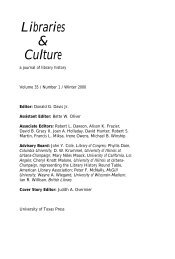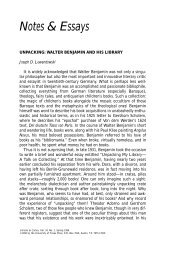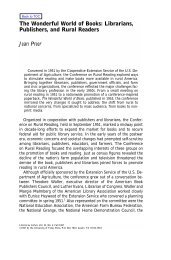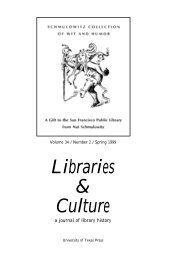The Library Historian's Field of Dreams - School of Information
The Library Historian's Field of Dreams - School of Information
The Library Historian's Field of Dreams - School of Information
You also want an ePaper? Increase the reach of your titles
YUMPU automatically turns print PDFs into web optimized ePapers that Google loves.
<strong>The</strong> <strong>Library</strong> Historian’s <strong>Field</strong> <strong>of</strong> <strong>Dreams</strong>:<br />
A Pr<strong>of</strong>ile <strong>of</strong> the First Nine Seminars<br />
Edward A. Goedeken<br />
History haunts me with a sense <strong>of</strong> lost opportunities.<br />
Louis Shores 1<br />
<strong>The</strong> <strong>Library</strong> History Seminars, founded by Louis Shores in 1961, have<br />
met about every five years ever since. Through a series <strong>of</strong> tables and<br />
charts, this essay examines various characteristics <strong>of</strong> the seminar participants,<br />
including their gender, institutional affiliation, and the topic and era<br />
<strong>of</strong> their presentations. <strong>The</strong> data are analyzed to provide a picture <strong>of</strong> who<br />
does library history and how the discipline’s research interests have<br />
evolved over the past thirty years.<br />
Like the farmer in the movie <strong>Field</strong> <strong>of</strong> <strong>Dreams</strong>, Louis Shores always<br />
believed that if he could build it, they would come—and they did. In<br />
1961, little more than a decade after Shores, Wayne Shirley, and Carl<br />
Milam founded the American <strong>Library</strong> History Round Table (ALHRT) in<br />
1947, the indefatigable Shores was ready to host the first <strong>Library</strong> History<br />
Seminar at Florida State University. 2 From that humble beginning (only<br />
sixteen library historians attended the 1961 meeting), the seminars have<br />
flourished. Over the years the number <strong>of</strong> attendees has steadily<br />
increased, with recent seminars attracting scholars from all corners <strong>of</strong><br />
the globe to share their affection for library history.<br />
Fortunately, the seminars’ proceedings have all been published, and as<br />
a group they represent a collection <strong>of</strong> individual snapshots <strong>of</strong> the state <strong>of</strong><br />
the art <strong>of</strong> library history over the past thirty-five years. 3 This essay analyzes<br />
the first nine seminars in order to arrive at generalizations about<br />
the nature <strong>of</strong> the craft <strong>of</strong> American library history. Emphasis is on the<br />
characteristics <strong>of</strong> these historians who laid the groundwork for our contemporary<br />
discipline.<br />
Specific information about each seminar and its participants was<br />
entered into a spreadsheet and then arranged to reveal information not<br />
readily accessible otherwise. Long-time members <strong>of</strong> the LHRT likely<br />
Libraries & Culture, Vol. 35, No. 1, Winter 2000<br />
2000 by the University <strong>of</strong> Texas Press, P.O. Box 7819, Austin, TX 78713-7819
162 L&C/<strong>The</strong> First Nine Seminars<br />
have an intuitive sense <strong>of</strong> the patterns that emerge from this approach;<br />
nevertheless, these findings should interest all members <strong>of</strong> the LHRT<br />
regardless <strong>of</strong> their length <strong>of</strong> association with our subspecialty. <strong>The</strong> tabular<br />
information that follows provides the framework for the narrative.<br />
Table 1 shows attendance by conference with data given for gender, followed<br />
by a column indicating the total number <strong>of</strong> participants, and<br />
finally by a column (LIS) that represents the percentage <strong>of</strong> presenters<br />
that are either practicing librarians or members <strong>of</strong> library science teaching<br />
faculty. It is common knowledge that women outnumber men in the<br />
library pr<strong>of</strong>ession as a whole and have for a long time. 4 Indeed, this belief<br />
was affirmed in 1994 when the American <strong>Library</strong> Association conducted<br />
a survey <strong>of</strong> its members that showed 78 percent as female. 5 This figure<br />
approximates the U.S. government census data for the decades since the<br />
<strong>Library</strong> History Seminars began in 1961: for the years 1960, 1970, 1980,<br />
and 1990, women comprised 86, 82, 84, and 83 percent, respectively. 6<br />
When we move, however, from the library pr<strong>of</strong>ession in general to its<br />
subdiscipline <strong>of</strong> library history, the demographics begin to shift from<br />
those that traditionally govern librarianship to those that describe the<br />
historical pr<strong>of</strong>ession in the United States since World War II. 7 For example,<br />
membership data from the LHRT indicates that the percentages are<br />
moving in the direction <strong>of</strong> equality in gender representation, with the<br />
1998 LHRT membership split at 42 percent male and 58 percent<br />
female. 8 Compared with percentages <strong>of</strong> seminar presenters as revealed<br />
in Table 1, it becomes even clearer that men dominated, at least in the<br />
early years. While the numbers <strong>of</strong> attendees fluctuated, gender percent-<br />
TABLE 1<br />
ATTENDANCE CHARACTERISTICS<br />
%<br />
Conference Male | Female Total # LIS%<br />
1961 100% | 0% 7 17<br />
1965 70 | 30 13 38<br />
1968 100 | 0 11 45<br />
1971 84 | 16 25 44<br />
1976 73 | 27 15 66<br />
1980 68 | 32 34 47<br />
1985 75 | 25 28 36<br />
1990 72 | 28 29 45<br />
1995 43 | 57 28 50<br />
Average 76 | 24 21 43
TABLE 2<br />
ALISE MEMBERSHIP BY GENDER<br />
ALISE Male Female<br />
1976 59% 41%<br />
1980 58 42<br />
1985 57 43<br />
1990 53 47<br />
1995 51 49<br />
ages show a relatively steady increase in women as presenters after 1971<br />
until a substantial jump in 1995, when women become a clear majority.<br />
Whether the 1995 figure is an aberration or indicative <strong>of</strong> an emerging<br />
trend will become clearer in the future.<br />
Another way to understand the impact <strong>of</strong> gender is with a longitudinal<br />
view <strong>of</strong> the percentage <strong>of</strong> women faculty members in library and information<br />
science programs. Data from the <strong>Library</strong> and <strong>Information</strong> Science<br />
Education Statistical Report, for years in common with the <strong>Library</strong> History<br />
Seminars, appear in Table 2. 9 It is readily apparent that women have<br />
steadily increased their presence among LIS faculties to the point <strong>of</strong> near<br />
equality by 1995. <strong>The</strong> growth <strong>of</strong> women as a percentage <strong>of</strong> the total is<br />
further evidenced by data that represent the number <strong>of</strong> women and men<br />
earning Ph.D.’s in history during the same time period. <strong>The</strong>se percentages<br />
are shown in Table 3 and again indicate a steady increase in the<br />
numbers <strong>of</strong> women who, especially beginning in the 1980s, earned doctorates<br />
in history. <strong>The</strong> inexorable increase <strong>of</strong> women as pr<strong>of</strong>essional<br />
TABLE 3<br />
PH.D.’S GRANTED IN HISTORY<br />
Year Male Female<br />
1960–61 93% 7%<br />
1964–65 91 9<br />
1968–69 87 13<br />
1970–71 88 12<br />
1975–76 78 22<br />
1980–81 69 31<br />
1985–86 67 33<br />
1990–91 64 36<br />
1993–94 63 37<br />
Ave. 74% 26%<br />
163
164 L&C/<strong>The</strong> First Nine Seminars<br />
historians and as members <strong>of</strong> LIS faculty over the past thirty years is<br />
mirrored in their involvement in <strong>Library</strong> History Seminars. Although<br />
women have long dominated librarianship, the opposite holds for the historical<br />
pr<strong>of</strong>ession until recently. That women are enjoying a stronger<br />
presence among those presenting papers at the seminars should not be<br />
surprising given overall trends in the numbers <strong>of</strong> women earning doctorates<br />
in history or joining LIS faculties since 1960. 10<br />
Tables 4 and 5 <strong>of</strong>fer more detailed information concerning the LIS presenters<br />
at the seminars. Table 4 identifies individuals who participated in<br />
at least two seminars. Robert V. Williams is the most active presenter,<br />
but Wayne Wiegand is a close second. Institutional affiliation fascinates<br />
investigators, and Table 5 shows this for the seminars’ LIS participants.<br />
Neither Mississippi State College for Women (now Mississippi University<br />
for Women) nor Purdue University has ever had LIS programs.<br />
Loughborough University is a British LIS school. <strong>The</strong> rest now have (or<br />
had at one time) LIS programs during the period under review. <strong>The</strong> preponderance<br />
<strong>of</strong> these institutions in Table 5 should not be surprising,<br />
since library school faculty are under greater pressure to engage in<br />
scholarly activity than librarians with nonteaching appointments.<br />
Although not supporting a library school, the library faculty at Purdue<br />
University, led by Mark Tucker, have for many years maintained an avid<br />
interest in library history.<br />
TABLE 4<br />
FREQUENT PAPER PRESENTERS BY NAME<br />
AND NUMBER OF TIMES PRESENTING<br />
Two Three Four Six<br />
Choldin Dain Wiegand Williams, R. V.<br />
Colson Gambee<br />
Harris, M. Jackson, E.<br />
Harris, N. Kaser<br />
Holley, E. Maack<br />
Johnson, D. McMullen<br />
Marcum Richards, P.<br />
Martin, R. Stieg (Darnton)<br />
Mish<strong>of</strong>f<br />
Rosenberg<br />
Rush<br />
Slavens<br />
Sturges<br />
Tucker
TABLE 5<br />
INSTITUTIONAL AFFILIATION FOR LIS OR LIBRARIANSHIP<br />
AND NUMBER OF TIMES AN INSTITUTION IS REPRESENTED<br />
Two Three Four Six Eight<br />
Catholic U. Case Western Res. Columbia Indiana U. U. <strong>of</strong> Illinois–<br />
MSt. for W. Kent State U. <strong>of</strong> Alabama U. <strong>of</strong> Chicago Chicago<br />
Rutgers U. Loughborough U. U. <strong>of</strong> Kentucky UNC–Chapel Hill<br />
UC-Berkeley Louisiana State U.<br />
UCLA Purdue<br />
Wayne St. Florida State<br />
U. <strong>of</strong> Michigan<br />
U. <strong>of</strong> Minnesota<br />
U. <strong>of</strong> South Carolina<br />
U. <strong>of</strong> Texas–Austin<br />
U. <strong>of</strong> Wisconsin–Madison<br />
A number <strong>of</strong> studies <strong>of</strong> library and information science scholars have<br />
considered institutional affiliation. 11 In library history, an examination <strong>of</strong><br />
institutional affiliation for Libraries & Culture and its predecessor, the<br />
Journal <strong>of</strong> <strong>Library</strong> History, by Jean-Pierre Hérubel revealed that faculty at<br />
the University <strong>of</strong> Texas, the University <strong>of</strong> North Carolina at Chapel Hill,<br />
and the University <strong>of</strong> Kentucky were prominently featured as authors. 12<br />
Although it is obvious that participation in the seminars represents a different<br />
type <strong>of</strong> scholarly involvement with the requirement <strong>of</strong> travel to a<br />
specific site, it is nevertheless useful to compare attendance at the seminars<br />
with the results <strong>of</strong> a recent study <strong>of</strong> those who attended the ACRL<br />
triennial conferences between 1978 and 1992. In the ACRL study, the top<br />
five institutions were the University <strong>of</strong> Illinois–Chicago, Purdue<br />
University, Indiana University, Ohio State University, and Penn State<br />
University. 13 Table 5 shows that Purdue University, Indiana University,<br />
and the University <strong>of</strong> Illinois–Chicago appear on both lists. Ironically, all<br />
three universities are located within a radius <strong>of</strong> 200 miles. What is it<br />
about these three institutions that has led them to support conference<br />
attendance more than others? Since only Indiana University hosts a<br />
library school, it is difficult to compare the three, but the fact remains<br />
that these schools demonstrate high involvement in conference activity.<br />
Indeed, the question <strong>of</strong> geographic representation is the subject <strong>of</strong> the<br />
next group <strong>of</strong> tables.<br />
Table 6 distributes the nine seminar participants by state and by pr<strong>of</strong>essional<br />
affiliation, either as teaching faculty or a library practitioner. It<br />
does not distinguish between library school faculty and non–library school<br />
faculty. <strong>The</strong> right-hand column indicates the percentage <strong>of</strong> participants<br />
from a state that are associated with librarianship. Table 7 further refines<br />
the data from the right-hand column <strong>of</strong> Table 6. Finally, Table 8 uses the<br />
165
166 L&C/<strong>The</strong> First Nine Seminars<br />
United States Census regional categories (arranged by number, not percentage)<br />
<strong>of</strong> Seminar participants who were LIS faculty to provide more<br />
detailed information about the regional characteristics <strong>of</strong> seminar participants.<br />
We can see that over the years the eastern portion <strong>of</strong> the Midwest<br />
and the southeastern part <strong>of</strong> the United States supplied most <strong>of</strong> the participants.<br />
Since these are aggregate figures, it is important to mention<br />
that the early seminars were held in Florida, giving that region a preponderance<br />
<strong>of</strong> attendees that it did not enjoy in subsequent seminars.<br />
Examination <strong>of</strong> individual seminars more clearly reveals this shift. Tables<br />
6, 7, and 8 provide a somewhat different picture <strong>of</strong> the seminars, but the<br />
TABLE 6<br />
PARTICIPANTS BY STATE AND OCCUPATION<br />
State Total LIS Non-LIS % LIS<br />
Alabama 4 4 0 100<br />
Arizona 2 1 1 50<br />
California 10 7 3 70<br />
Florida 13 6 7 46<br />
Georgia 4 3 1 75<br />
Illinois 23 18 5 72<br />
Indiana 10 9 1 90<br />
Kentucky 6 6 0 100<br />
Louisiana 3 3 0 100<br />
Maryland 3 0 3 0<br />
Massachusetts 7 3 4 42<br />
Michigan 6 6 0 100<br />
Minnesota 3 2 1 66<br />
Mississippi 2 2 0 100<br />
New Jersey 2 2 0 100<br />
New York 18 10 8 55<br />
North Carolina 10 9 1 90<br />
Ohio 8 8 0 100<br />
Pennsylvania 2 2 0 100<br />
South Carolina 4 4 0 100<br />
Tennessee 2 1 1 50<br />
Texas 12 4 8 33<br />
Virginia 2 2 0 100<br />
Washington, D.C. 8 6 2 75<br />
Washington 1 1 0 100<br />
Wisconsin 3 3 0 100<br />
Total 168 122 (73%) 46 (27%)
TABLE 7<br />
GEOGRAPHIC LOCATION OF LIS PARTICIPANTS AS<br />
PERCENTAGE OF TOTAL PARTICIPANTS<br />
0–25% 26–50% 51–75% 76–100%<br />
Maryland Arizona California Alabama<br />
Florida Georgia Indiana<br />
Massachusetts Illinois Kentucky<br />
Tennessee Minnesota Louisiana<br />
Texas New York Michigan<br />
Washington, D.C. Mississippi<br />
New Jersey<br />
North Carolina<br />
Ohio<br />
Pennsylvania<br />
South Carolina<br />
Virginia<br />
Washington<br />
Wisconsin<br />
dominance <strong>of</strong> the Midwest reflected in Table 5 is confirmed by these data<br />
as well. Moreover, when all nine seminars are examined, the West is<br />
poorly represented, with only California making much <strong>of</strong> a showing.<br />
Table 9 takes the subject matter <strong>of</strong> the presentations and categorizes<br />
them roughly into a matrix defined by chronology and topic. 14 <strong>The</strong> table<br />
reflects the primary historical periods <strong>of</strong> the presentations. By way <strong>of</strong><br />
TABLE 8<br />
DETAILED CENSUS<br />
REGIONAL BREAKDOWN<br />
West/Pacific 11<br />
West/Mountain 2<br />
Midwest/West North Central 3<br />
Midwest/East North Central 50<br />
Northeast/Middle Atlantic 22<br />
Northeast/New England 7<br />
South/West South Central 15<br />
South/East South Central 14<br />
South/Atlantic 44<br />
Total 168<br />
167
168 L&C/<strong>The</strong> First Nine Seminars<br />
TABLE 9<br />
PRESENTATIONS BY SUBJECT AND ERA<br />
SUB Gen Pre-16 16 17 18/1 18/2 19 19/1 19/2 20 20/1 20/2 Ttl<br />
Aca 3 3<br />
Ass 3 1 2 4 10<br />
Bio 1 1 1 2 4 1 8 18<br />
Bk 5 1 1 1 2 1 3 1 1 16<br />
Gen 12 1 2 1 16<br />
His 13 1 3 17<br />
LC 1 1 1 3<br />
LIS 1 3 4<br />
Pr 1 1 2 1 2 2 9<br />
Pu 7 1 1 8 2 1 20<br />
Sp 1 1 1 3 1 2 1 10<br />
Wo 1 2 3<br />
Ttl 44 1 2 2 5 1 4 12 25 9 19 5<br />
AcaAcademic; AssAssociations; BioBiography; BkBooks and Reading;<br />
GenGeneral; HisHistoriography; LC<strong>Library</strong> <strong>of</strong> Congress; LIS<strong>Library</strong> and<br />
<strong>Information</strong> Science Education; PrPrivate Libraries; PuPublic Libraries;<br />
SpSpecial Libraries; WoWomen in Librarianship; TtlTotal<br />
further explanation, 19/1 means the period from 1800 to 1850, and 19/2<br />
covers the period from 1851 to 1899. It was not necessary to divide the<br />
sixteenth and seventeenth centuries since discussants treated them<br />
broadly. <strong>The</strong> nineteenth and twentieth centuries, which generated more<br />
detailed interest, required an entire column for papers whose subjectmatter<br />
treated those entire centuries. <strong>The</strong> subject areas to the left are<br />
derived from the arrangements used in the biennial Libraries & Culture<br />
literature reviews. Table 9 reveals that many <strong>of</strong> the papers were either on<br />
very broad topics that defied categorization or were devoted to large<br />
spans <strong>of</strong> time and thus fell into the General category; and the recent<br />
period garnered the most attention, which is not surprising since U.S.<br />
topics dominated the seminar papers, and our history is relatively short<br />
in duration. Nor should this be surprising since the latter part <strong>of</strong> the<br />
nineteenth and early part <strong>of</strong> the twentieth centuries comprise the bulk <strong>of</strong><br />
the reported research. Most <strong>of</strong> our subdiscipline’s historiography has been<br />
focused on this formative era from around 1870 through World War II.<br />
Although the table does not show it, the five papers devoted to the last<br />
half <strong>of</strong> the twentieth century were all given at the 1995 seminar. As time<br />
progresses, the period after 1950 will increasingly become eligible for<br />
vigorous scholarly investigation. Table 9 also shows that presentations
devoted to public libraries and biographical topics have been plentiful<br />
over the years, with historiography and books and reading close behind.<br />
Indeed, Table 9 indicates that research into books and reading spans<br />
almost the entire chronology. Moreover, interest in this topic has grown<br />
steadily in the past ten years, with several presentations devoted to books<br />
and reading at both the 1985 and the 1990 seminars. 15 On the other<br />
hand, academic libraries, the <strong>Library</strong> <strong>of</strong> Congress, and women as librarians<br />
have been the least explored topics. It should be mentioned here,<br />
however, that the two papers on women in librarianship appeared at the<br />
1995 seminar. Increased interest in that topic will likely occur in future<br />
seminars.<br />
Analyzing the seminars by subject and historically significant time periods<br />
is difficult, and certainly more perspectives are possible. For example,<br />
the arrangement <strong>of</strong> Table 9 could be applied to each seminar, charting in<br />
more detail the shifting landscape <strong>of</strong> topics that intrigued library historians<br />
at each stop along the way. I will leave this task for future investigators.<br />
<strong>The</strong> <strong>Library</strong> History Seminars, launched in 1961 by the energetic<br />
Shores and his colleagues, are still alive and well as the century ends. <strong>The</strong><br />
dozens and dozens <strong>of</strong> scholars who have shared their research at the nine<br />
seminars over the past four decades testify to the intellectual vigor that<br />
Shores, Shirley, and Milam believed possible for the fledgling American<br />
<strong>Library</strong> History Round Table. Building on a tradition <strong>of</strong> hearing learned<br />
presentations started in the middle <strong>of</strong> the seventeenth century by members<br />
<strong>of</strong> the Royal Society <strong>of</strong> London, the seminars have built a solid foundation<br />
<strong>of</strong> enduring scholarship. <strong>The</strong> diverse nature <strong>of</strong> the topics pursued<br />
over the years and the range <strong>of</strong> institutions represented reflect the<br />
expanding appeal <strong>of</strong> library history as a worthwhile intellectual endeavor<br />
for library scholars throughout not only the United States but other<br />
nations as well. This pr<strong>of</strong>ile has sought to show who we were and where we<br />
came from between 1961 and 1995; future seminars should chart where<br />
our discipline will go in the next century.<br />
Notes<br />
169<br />
1. Louis Shores, Quiet World: A Librarian’s Crusade for Destiny (Hamden, Conn.:<br />
Linnet Books, 1975), 231. A good source for Shores’s views on the value <strong>of</strong> library<br />
history can be found in his “<strong>The</strong> Importance <strong>of</strong> <strong>Library</strong> History,” in John David<br />
Marshall, ed., An American <strong>Library</strong> History Reader: Contributions to <strong>Library</strong> Literature<br />
(Hamden, Conn.: Shoe String Press, 1961), 3–7.<br />
2. Shores, Quiet World, 231–34; Lee Shiflett, Louis Shores: Defining Educational<br />
Librarianship (Lanham, Md.: Scarecrow Press, 1996), 213. Shores also reflected on<br />
Wayne Shirley’s influence in “Wayne Shirley: In Memoriam,” Journal <strong>of</strong> <strong>Library</strong><br />
History 9 (October 1974): 291–92.<br />
3. <strong>The</strong> proceedings <strong>of</strong> the <strong>Library</strong> History Seminars have been published in<br />
the following: John D. Marshall, ed., In Pursuit <strong>of</strong> <strong>Library</strong> History, <strong>Library</strong> History
170 L&C/<strong>The</strong> First Nine Seminars<br />
Seminar 1, Proceedings, 1961 (Tallahassee: Florida State University <strong>Library</strong><br />
<strong>School</strong>, 1961); John D. Marshall, ed., Approaches to <strong>Library</strong> History, <strong>Library</strong> History<br />
Seminar 2, Proceedings, 1965 (Tallahassee: Journal <strong>of</strong> <strong>Library</strong> History, 1966);<br />
Martha Jane K. Zachert, ed., <strong>Library</strong> History Seminar, No. 3, Proceedings, 1968<br />
(Tallahassee: Journal <strong>of</strong> <strong>Library</strong> History, 1968); Harold Goldstein and John<br />
Goudeau, eds., <strong>Library</strong> History Seminar, No. 4, Proceedings, 1971 (Tallahassee: Florida<br />
State University <strong>School</strong> <strong>of</strong> <strong>Library</strong> Science, 1972); Harold Goldstein, ed.,<br />
Milestones to the Present: Papers from <strong>Library</strong> History Seminar V (Syracuse, N.Y.: Gaylord<br />
Pr<strong>of</strong>essional Publications, 1978); Donald G. Davis, Jr., ed., Libraries & Culture:<br />
Proceedings <strong>of</strong> <strong>Library</strong> History Seminar VI, 19–22 March 1980, Austin, Texas (Austin:<br />
University <strong>of</strong> Texas Press, 1981); Donald G. Davis, Jr., ed., Libraries, Books &<br />
Culture: Proceedings <strong>of</strong> the <strong>Library</strong> History Seminar VII, 6–8 March 1985, Chapel Hill,<br />
North Carolina (Austin: Graduate <strong>School</strong> <strong>of</strong> <strong>Library</strong> and <strong>Information</strong> Science,<br />
University <strong>of</strong> Texas at Austin, 1986); Donald G. Davis, Jr., ed., Reading & Libraries:<br />
Proceedings <strong>of</strong> the <strong>Library</strong> History Seminar VIII, 9–11 May 1990, Bloomington, Indiana<br />
(Austin: Graduate <strong>School</strong> <strong>of</strong> <strong>Library</strong> and <strong>Information</strong> Science, University <strong>of</strong><br />
Texas at Austin, 1991); and Donald G. Davis, Jr., ed., Libraries & Philanthropy:<br />
Proceedings <strong>of</strong> <strong>Library</strong> History Seminar IX, 30 March–1 April, 1995, University <strong>of</strong><br />
Alabama, Tuscaloosa (Austin: Graduate <strong>School</strong> <strong>of</strong> <strong>Library</strong> and <strong>Information</strong> Science,<br />
University <strong>of</strong> Texas at Austin, 1996).<br />
Reviews <strong>of</strong> several <strong>of</strong> the seminars are available: Elmer D. Johnson, review<br />
<strong>of</strong> <strong>Library</strong> History Seminar, No. 3, Proceedings, 1968, in Journal <strong>of</strong> <strong>Library</strong> History 6<br />
(October 1971): 376–79; Betsy Vantine, “Special Report: <strong>Library</strong> History Seminar<br />
Eyes Libraries & Culture [<strong>Library</strong> History Seminar, No. 6, 1980],” <strong>Library</strong> Journal 105<br />
(June 1980): 1254–58 (it should be noted that Vantine errs in saying this is the<br />
fourth seminar); Millicent Huff, “Libraries and Culture: A Brief Report <strong>of</strong><br />
<strong>Library</strong> History Seminar VI,” Journal <strong>of</strong> <strong>Library</strong> History 15 (Summer 1980): 309–19;<br />
Mary Pound, “Libraries, Books & Culture: A Brief Report <strong>of</strong> <strong>Library</strong> History<br />
Seminar VII,” Journal <strong>of</strong> <strong>Library</strong> History 20 (Fall 1985): 434–38; Ralph Lee Scott,<br />
“Libraries, Books, and Culture,” North Carolina Libraries 43 (Summer 1985): 108–9;<br />
James V. Carmichael, Jr., “Reading & Libraries: A Brief Report <strong>of</strong> <strong>Library</strong> History<br />
Seminar VIII,” Libraries & Culture 26 (Summer 1991): 540–46; P. Toby Graham,<br />
“Libraries & Philanthropy: <strong>The</strong> Proceedings <strong>of</strong> <strong>Library</strong> History Seminar IX,<br />
Spring 1995, the University <strong>of</strong> Alabama, Tuscaloosa,” Libraries & Culture 32 (Fall<br />
1997): 470–73; and John Feather, “Libraries & Philanthropy: <strong>The</strong> Proceedings <strong>of</strong><br />
<strong>Library</strong> History Seminar IX,” <strong>Library</strong> Quarterly 68 (April 1998): 231–32.<br />
4. For general data, see Anita R. Schiller, “Women in Librarianship,” in<br />
Kathleen Weibel and Kathleen M. Heim, eds., <strong>The</strong> Role <strong>of</strong> Women in Librarianship<br />
1876–1976: <strong>The</strong> Entry, Advancement, and Struggle for Equalization in One Pr<strong>of</strong>ession<br />
(Phoenix, Ariz.: Oryx Press, 1979), 222–56. Another good historical source is the<br />
collection <strong>of</strong> essays edited by Heim, <strong>The</strong> Status <strong>of</strong> Women in Librarianship: Historical,<br />
Sociological, and Economic Issues (New York: Neal-Schuman Publishers, 1983).<br />
5. Mary Jo Lynch and Gerald Hodges, “1993 ALA Member Opinion Survey<br />
Reveals One New Major Player,” American Libraries 25 (June 1994): 598.<br />
6. Census data for the period from 1870 to 1970 are summarized by Schiller,<br />
“Women in Librarianship,” 238, Table VII. Data for 1980 came from 1980 Census <strong>of</strong><br />
Population. Detailed Occupation <strong>of</strong> the Experienced Civilian Labor Force by Sex for the United<br />
States Regions: 1980 and 1970. Supplemental Report (Washington, D.C.: U.S.<br />
Department <strong>of</strong> Commerce, Bureau <strong>of</strong> the Census, 1984), 26. <strong>The</strong> 1990 figure<br />
comes from “Census 90: Detailed Occupation by Race, Hispanic Origin and Sex,”<br />
Censtats: An Electronic Subscription Service http://tier2.gov/cgi-win/eeo/eeodata.exe.
171<br />
7. <strong>The</strong> best overall view <strong>of</strong> the historical pr<strong>of</strong>ession, especially for the period<br />
after World War II, is by Peter Novick, That Noble Dream: <strong>The</strong> Objectivity Question and<br />
the American Historical Pr<strong>of</strong>ession (New York: Cambridge University Press, 1988).<br />
Also useful is John Higham’s magisterial survey, History: Pr<strong>of</strong>essional Scholarship in<br />
America, updated paperback ed. (Baltimore: Johns Hopkins University Press,<br />
1989). For women as historians from a broad perspective, see Joan Scott, Gender<br />
and the Politics <strong>of</strong> History (New York: Columbia University Press, 1988) and Bonnie<br />
G. Smith, <strong>The</strong> Gender <strong>of</strong> History: Men, Women, and Historical Practice (Cambridge,<br />
Mass.: Harvard University Press, 1998). In her book, Scott has an excellent chapter<br />
devoted to women historians from 1884 to 1994. Two older works that are still<br />
valuable are Jessie Bernard, Academic Women (University Park: Pennsylvania State<br />
University Press, 1964), and Lucille Addison Pollard, Women on College and<br />
University Faculties: A Historical Survey and a Study <strong>of</strong> <strong>The</strong>ir Present Academic Status<br />
(New York: Arno Press, 1977). For more on the background to the development<br />
<strong>of</strong> modern women historians, see Jacqueline Goggin, “Challenging Sexual<br />
Discrimination in the Historical Pr<strong>of</strong>ession: Women Historians and the American<br />
Historical Association, 1890–1940,” American Historical Review 97 (June 1992):<br />
769–802.<br />
8. Personal e-mail correspondence to the author from Catherine Sias,<br />
American <strong>Library</strong> Association, 13 July 1998.<br />
9. Timothy W. Sineath, ed., <strong>Library</strong> and <strong>Information</strong> Science Education Statistical<br />
Report 1995 (Raleigh, N.C.: Association for <strong>Library</strong> and <strong>Information</strong> Science<br />
Education, 1995), 5.<br />
10. In Table 3, the source for the years 1960–61 is Wayne E. Tolliver, Earned<br />
Degrees Conferred, 1960–1961: Bachelor’s and Higher Degrees (Washington, D.C.: U.S.<br />
Department <strong>of</strong> Health, Education and Welfare, 1963), 223. Data for the rest <strong>of</strong><br />
the years in Table 3 were found in the appropriate volumes <strong>of</strong> Digest <strong>of</strong> Education<br />
Statistics (Washington, D.C.: U.S. Department <strong>of</strong> Health, Education and<br />
Welfare), with the publication date in parentheses: for 1964–65, p. 81 (1966); for<br />
1970–71, p. 102 (1972); for 1975–76, p. 113 (1977–78). For 1980 on, the sponsoring<br />
agency for this statistical series changed to the Department <strong>of</strong> Education: for<br />
1980–81, p. 117 (1983–84); for 1985–86, p. 201 (1988); for 1990–91, p. 254 (1993);<br />
for 1993–94, p. 284 (1997).<br />
11. Some recent studies that examine institutional affiliation include Paula D.<br />
Watson, “Production <strong>of</strong> Scholarly Articles by Academic Librarians and <strong>Library</strong><br />
<strong>School</strong> Faculty,” College & Research Libraries 46 (July 1985): 334–42; John M. Budd<br />
and Charles A. Seavey, “Characteristics <strong>of</strong> Journal Authorship by Academic<br />
Librarians,” College & Research Libraries 51 (September 1990): 463–70; John M.<br />
Budd and Charles A. Seavey, “Productivity <strong>of</strong> U.S. <strong>Library</strong> and <strong>Information</strong><br />
Science Faculty: <strong>The</strong> Hayes Study Revisited,” <strong>Library</strong> Quarterly 66 (January 1996):<br />
1–20; A. Neil Yerkey, “Publishing in <strong>Library</strong> and <strong>Information</strong> Science: Audience,<br />
Subjects, Affiliation, Source, and Format,” <strong>Library</strong> & <strong>Information</strong> Science Research 15<br />
(Spring 1993): 165–83; James L. Terry, “Authorship in College & Research<br />
Libraries Revisited: Gender, Institutional Affiliation, Collaboration,” College &<br />
Research Libraries 57 (July 1996): 377–83; and a comparison with all faculty can be<br />
found in John M. Budd, “Faculty Publishing Productivity: An Institutional<br />
Analysis and Comparison with <strong>Library</strong> and Other Measures,” College & Research<br />
Libraries 56 (November 1995): 547–54.<br />
12. Jean-Pierre V. M. Hérubel, “Authorship, Gender, and Institutional<br />
Affiliation in <strong>Library</strong> History: <strong>The</strong> Case <strong>of</strong> Libraries & Culture,” Behavioral & Social<br />
Sciences Librarian 11, no. 1 (1991): 53.
172 L&C/<strong>The</strong> First Nine Seminars<br />
13. Anne L. Buchanan, Edward A. Goedeken, and Jean-Pierre V. M. Hérubel,<br />
“Scholarly Communication among Academic Librarians: An Analysis <strong>of</strong> Six<br />
ACRL Proceedings,” Behavioral & Social Sciences Librarian 14, no. 2 (1996): 9.<br />
14. This table was created using a simplistic form <strong>of</strong> content analysis to assign<br />
categories for the presentations. <strong>The</strong> basic text for this methodology is Klaus<br />
Kripendorff, Content Analysis: An Introduction to Its Methodology (Beverly Hills, Calif.:<br />
Sage Publications, 1980). Also quite useful is Robert Philip Weber, Basic Content<br />
Analysis, 2nd ed. (Newberry Park, Calif.: Sage Publications, 1990). A fine current<br />
literature review can be found in Daniel Riffe and Alan Freitag, “A Content<br />
Analysis <strong>of</strong> Content Analyses: Twenty-five Years <strong>of</strong> Journalism Quarterly,”<br />
Journalism & Mass Communication Quarterly 74 (Winter 1997): 873–82.<br />
15. Wayne Wiegand provides an informative overview <strong>of</strong> the burgeoning literature<br />
devoted to the study <strong>of</strong> print culture in “Introduction: <strong>The</strong>oretical<br />
Foundations for Analyzing Print Culture as Agency and Practice in a Diverse<br />
Modern America,” in James P. Danky and Wayne A. Wiegand, eds., Print Culture<br />
in a Diverse America (Urbana: University <strong>of</strong> Illinois Press, 1998), 1–13.



